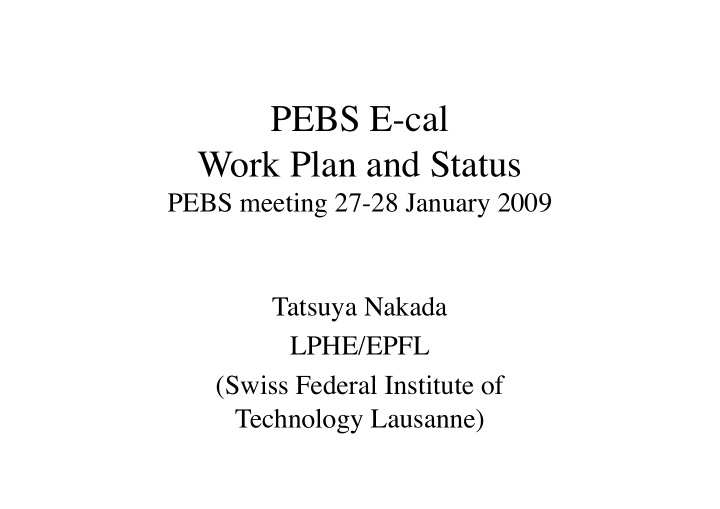



PEBS E-cal Work Plan and Status PEBS meeting 27-28 January 2009 � Tatsuya Nakada � LPHE/EPFL � (Swiss Federal Institute of Technology Lausanne) �
PEBS E-Cal � • � Identi fi cation of e/hadron by E / p and shower development (up to few 100 GeV/ c ) � • � Tracking of minimum ionising particles � • � Space, weight and power constraints � • � Keep commonality with other detectors as much as possible �
Proposed solution � • � W-scintillator sampling calorimeter with lateral segmentation: � – � Sampling part: scintillator bar with embedded WLS- fi bre � – � Photon readout with MPPC (SiPMT) � – � Electronics very similar to the fi bre-tracker (same FE chips and functionality but adjusted to different geometrical constraints) �
Detector Parameters � • � Size of the active area � • � Thickness of the W converter and number of layers � • � Thickness and lateral size of the scintillator bar � • � Dimension of the WLS- fi bre � fi rst optimization was done by Aachen-ITEP 2mm W and 2mm scintillator: 4 � 5=20 layers ( x � y coordinate), 11.4 X 0 (0.2 � 20/0.35) �
������������� ������������������������ ������� �������������������� �������� ������� ������������������������ �������������
������������������ ������������������������ ����������������� ������������������� ������������ ������������ ������� ������������� ������������� ������� ������� ������������������������
• � WLS- fi bre � = 1mm � • � MPPC both sides, one with a fi lter to reduce n �� • � Modi fi ed Hamamatsu MPPC � Commercial one � Modi fi ed one � 1.4 � 1.4mm 2 with 25 � 25 μ m 2 pixel (56 2 pixels) � No-magnetic pins � 300 ordered and expected in W-12, i.e. mid March 09 � acceptance issue by JBM �
Work Plan � • � Construction of prototype E-cal ������������ ������ ������ ����� ������ With SPIROC based electronics Beam tent in Autumn 2009
• � GEANT4 studies for the prototype and further optimisaion of the PEBS E-cal, in view of new physics input � ) � LS � • � Electronics and MPPC studies, e.g. gain stability etc. � • � Mechanical design of PEBS E-cal � � ) Software framework in a modular structure would be welcome for developing subsystem software… �
Group involved so far � • � Aachen: mechanics, electronics � • � ITEP: mechanical assembly � • � EPFL: Hamamatsu MPPC, electronics, fi nal assembly, simulation � • � Tsinghua: electronics � EPBS-Ecal is not big � a better logistic of the detector construction would be more ef fi cient? �
Recommend
More recommend